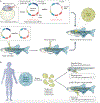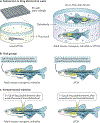Zebrafish patient avatars in cancer biology and precision cancer therapy
- PMID: 32251397
- PMCID: PMC8011456
- DOI: 10.1038/s41568-020-0252-3
Zebrafish patient avatars in cancer biology and precision cancer therapy
Abstract
In precision oncology, two major strategies are being pursued for predicting clinically relevant tumour behaviours, such as treatment response and emergence of drug resistance: inference based on genomic, transcriptomic, epigenomic and/or proteomic analysis of patient samples, and phenotypic assays in personalized cancer avatars. The latter approach has historically relied on in vivo mouse xenografts and in vitro organoids or 2D cell cultures. Recent progress in rapid combinatorial genetic modelling, the development of a genetically immunocompromised strain for xenotransplantation of human patient samples in adult zebrafish and the first clinical trial using xenotransplantation in zebrafish larvae for phenotypic testing of drug response bring this tiny vertebrate to the forefront of the precision medicine arena. In this Review, we discuss advances in transgenic and transplantation-based zebrafish cancer avatars, and how these models compare with and complement mouse xenografts and human organoids. We also outline the unique opportunities that these different models present for prediction studies and current challenges they face for future clinical deployment.
Conflict of interest statement
Competing interests
L.I.Z. is a founder and stockholder of Fate Therapeutics Inc., Scholar Rock and Camp4 Therapeutics Inc., and is a scientific adviser for Stemgent. The other authors declare no competing interests.
Figures



References
-
- National Cancer Institute. Targeted cancer therapies. NCI https://www.cancer.gov/about-cancer/treatment/types/targeted-therapies/t... (2020).
-
- Morrison C Fresh from the biotech pipeline — 2018. Nat. Biotechnol 37, 118–123 (2019). - PubMed
-
- Clohessy JG & Pandolfi PP Mouse hospital and co-clinical trial project — from bench to bedside. Nat. Rev. Clin. Oncol 12, 491 (2015). - PubMed
-
This review discusses mouse co-clinical trials for precision cancer therapy.
Publication types
MeSH terms
Substances
Grants and funding
LinkOut - more resources
Full Text Sources
Medical

